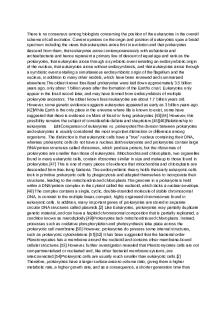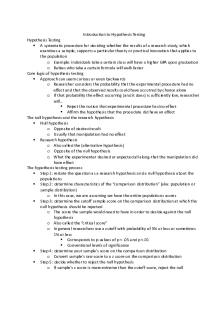5- seepage 2D PPT - Lecture notes 5 PDF

| Title | 5- seepage 2D PPT - Lecture notes 5 |
|---|---|
| Course | Soil Behaviour |
| Institution | University of Technology Sydney |
| Pages | 38 |
| File Size | 2.5 MB |
| File Type | |
| Total Downloads | 57 |
| Total Views | 156 |
Summary
lecture notes seepage 2D with relevant examples...
Description
Darcy’s Law for Groundwater Flow
Groundwater Flow
Coefficient of permeability in the field
SOIL BEHAVIOUR (Part 5 ) Two Dimensional Seepage (Flow Net) Hadi Khabbaz Email: [email protected] Room 2.520
Continuity Equation - Unit thickness in y direction. - Total rate of inflow = total rate of outflow:
z
- Isotropic permeability: k x = kz = k
dz
dx x
Laplace’s Equation
It represents an infinite number of mutually perpendicular curves. One group of curves shows paths of water and called flow lines. Total head gradually decreases along a flow line.
Laplace’s Equation Another group represent lines on which the total head is constant and called equipotential lines. These lines are contours of constant total head. Flow lines and equipotential lines are orthogonal (intersects at 90˚). A selected number of flow lines and equipotential lines constructs a flow net.
Flow Lines
Equipotential Lines
Flow Net
Properties of Flow Net Q
L1
Assuming: h1=h2=h
A1
L2
A2
Q
Properties of Flow Net Assuming: h1=h2=h3=h Q3
Q1
A3
h
L1
L3
A1
L2
h+h
A2
Rate of Flow Q
L1
No. of head drops=Nh A1
L2
A2
No. of flow channels=Nf
Q
Properties of Flow Net
It is most convenient to draw a flow net so that the head drop between two adjacent equipotential lines, h, is the same. The flow net is comprised of squares Each flow tube carries the same flow Q. Rate of flow can be calculated from a flow net as: Total head loss
Flow per unit length in y Coefficient of permeability
Number of flow channels
Number of equipotential drops
Sketching Flow Net
The flow net must be comprised of a family of orthogonal lines, defining a curvilinear square mesh, that also satisfy the boundary conditions. Some of the more common boundary conditions are: A submerged
soil boundary is an equipotential. An impermeable soil boundary is a flow Line. Any line of constant pore pressure is defined as phreatic line where the head drop is equal to the elevation drop on that line. Any axis of symmetry can be a part of flow lines.
Procedure for Sketching Flow Nets 1. Mark all boundary conditions. 2. Draw a coarse net which is consistent with the boundary conditions and which has orthogonal equipotential and flow lines. It is usually easier to visualise the pattern of flow so start by drawing the flow lines.
Procedure for Sketching Flow Nets 3.Modify the mesh so that it meets the conditions outlined above and any rectangle between adjacent flow lines and equipotential lines becomes a curvilinear square. 4. Refine the flow net by repeating the previous step and subdividing the coarse net.
Example of Flow Nets Phreatic line: equipotential drop = elevation drop Submerged surface boundary = equipotential line
Vertical drain
Weephole
Impermeable boundary = flow line
Flow rate?
What is H?
Vertical drain h Weephole
h=H/Nh
Example of Flow Nets Submerged boundary = equipotential line
Impermeable boundary = flow line
Example of Flow Nets Submerged boundary = equipotential line Phreatic line: equipotential drop = elevation drop
Impermeable boundary = flow line
Calculation of Seepage Example 1: Trench excavated under water, water pumped out. Q=? k = 610-6 m/s ’vx=? t = 18.2 kN/m3 Quick conditions ? Pore pressure distribution on the sheet pile wall = ? 10.8m 2.1m 1.2m x 4.5m
2.8m
4m
Calculation of Pressure Distribution of pore water pressure on the sheet pile? H
he
hp
10.1 10.1
0.0
10.1
8.0
2.1
9.8
6.8
3.0
2.1m
1.2m
H 10.1 H 6.8
9.8
2.8m
7.1 9.5 7.4 9.2
4m
7.7 8.0
8.9 8.6
8.3
9.5
5.7
3.8
9.2 8.9
4.7 4.0
4.5 4.9
H
he
hp
6.8
6.8
0
7.1
5.8
1.3
7.4
5.2
2.2
7.7 8.0
4.5 4
3.2 4.0
Calculation of Pressure Distribution of pore water pressure on the sheet pile? hp
u
0.0
0.0
2.1
20.6
2.1m
1.2m
H 10.1 H 6.8
9.8
2.8m
7.1 9.5 7.4 9.2
4m
7.7 8.0
8.9 8.6
8.3
3.0
29.4
3.8
37.2
4.5 4.9
44.1 48.0
hp
u
0
0
1.3
12.7
2.2
21.6
3.2 4.0
21.4 39.2
Anisotropic Permeability In many soils the permeability in horizontal direction is not similar to the permeability in vertical direction.
Isotropic
Anisotropic
Anisotropic Permeability
The Laplace’s equation given before is valid for isotropic soils.
A general form of Laplace’s equation can be obtained for anisotropic soils:
A practical way to solve the general Laplace’s equation is to transform the coordinates.
Anisotropic Permeability Coordinate transformation: or
Assume: x =xt then: If
then:
It means that if all dimensions in x-direction are divided by , the problem can be treated the same as isotropic soils with an equivalent permeability of:
Anisotropic Permeability Example: x = xt xt = x / = x / 2
kx=410-5 m/s kz=110-5 m/s
12m 28m
z x
Real dimensions
Anisotropic Permeability Example: x = xt xt = x / = x / 2
kx=410-5 m/s kz=110-5 m/s
keq=210-5 m/s 12m 14m
z xt
Transformed dimensions
Exam 2004 A long concrete walled coffer dam has been installed across a section of river. Excavation has proceeded between the concrete Flow Tube 3
walls on either side of the dam. Steady seepage is occurring into the excavated section of the dam. The coefficient of permeability of the soil around the dam is 10-4 m/s. Note the flow net has only been drawn for half the coffer dam because of symmetry.
1m
Concrete wall
Excavation side
4m
3m
5m
Exam 2004 i) Determine the flow that is occurring through Flow Tube 3 which is marked on the flow net. 1m
Concrete wall
Flow Tube 3
ii) What pump capacity, in m3 /s per metre run, would be required to maintain the water levels at the levels indicated on the flow net?
Excavation side
4m
3m A B
iii) Find the resultant uplift water force on the base AB of the 1m wide concrete wall.
5m
Solution Part i) Flow Tube 3
Part ii) Total Flow
Part iii) Uplift Force
H = 9.33
Assume linear variation
H = 10.33
H = 10
H = 9.66
hp = 5.33
hp = 5
hp = 4.66
u = 52.3
u = 49
u = 45.7
u = 42.4 u = 52.3
F
hp = 4.33 u = 42.4...
Similar Free PDFs

5- seepage 2D PPT - Lecture notes 5
- 38 Pages

PPT-5 - Lecture notes 2
- 12 Pages

5 - Lecture notes 5
- 4 Pages

Lesson 5 - Lecture notes 5
- 22 Pages

5 Statehood - Lecture notes 5
- 4 Pages

Prokaryotes 5 - Lecture notes 5
- 2 Pages

5. Conduct - Lecture notes 5
- 4 Pages

Chapter 5 - Lecture notes 5
- 15 Pages

Chapter-5 - Lecture notes 5
- 6 Pages

Chapter 5 - Lecture notes 5
- 83 Pages

Tutorial 5 - Lecture notes 5
- 3 Pages

Chapter 5 - Lecture notes 5
- 4 Pages

Imagen 5 - Lecture notes 5
- 1 Pages

Quiz 5 - Lecture notes 5
- 11 Pages

Chapter 5 - Lecture notes 5
- 20 Pages
Popular Institutions
- Tinajero National High School - Annex
- Politeknik Caltex Riau
- Yokohama City University
- SGT University
- University of Al-Qadisiyah
- Divine Word College of Vigan
- Techniek College Rotterdam
- Universidade de Santiago
- Universiti Teknologi MARA Cawangan Johor Kampus Pasir Gudang
- Poltekkes Kemenkes Yogyakarta
- Baguio City National High School
- Colegio san marcos
- preparatoria uno
- Centro de Bachillerato Tecnológico Industrial y de Servicios No. 107
- Dalian Maritime University
- Quang Trung Secondary School
- Colegio Tecnológico en Informática
- Corporación Regional de Educación Superior
- Grupo CEDVA
- Dar Al Uloom University
- Centro de Estudios Preuniversitarios de la Universidad Nacional de Ingeniería
- 上智大学
- Aakash International School, Nuna Majara
- San Felipe Neri Catholic School
- Kang Chiao International School - New Taipei City
- Misamis Occidental National High School
- Institución Educativa Escuela Normal Juan Ladrilleros
- Kolehiyo ng Pantukan
- Batanes State College
- Instituto Continental
- Sekolah Menengah Kejuruan Kesehatan Kaltara (Tarakan)
- Colegio de La Inmaculada Concepcion - Cebu
